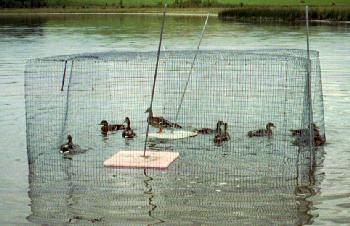Help the NJ Division of Fish and Wildlife with Duck Banding!By Ted NicholsWaterfowl Ecology and Management Program Each year biologists and cooperators with the New Jersey Department of Environmental Protection's Division of Fish and Wildlife, Waterfowl Ecology and Management Program, trap and mark ducks with legbands. This program is part of a nationwide monitoring effort for migratory game birds. In order to facilitate geographic specific recovery and survival rates, duck banding is targeted at local birds. As such, all duck banding is conducted between July 1 and September 30, before the onset of the majority of the fall migration in October. The banding effort is directed toward the common breeding species: mallards, black ducks and wood ducks. Banding data gives us information on the proportion of the duck population that is harvested during hunting seasons, the timing of when ducks are harvested as well as information on their migration patterns. The information gathered from banding is used to guide management decisions and monitor the effects of these decisions. Ducks are captured by luring them into wire traps or to rocket net sites by using bait. Traps are baited and tended daily. At rocket net sites, the net is fired over feeding ducks after several consecutive days of birds feeding at the site.
How can you help?
1. Tend and bait one of our sites.
In our experience, hooking up a site with a dedicated person that lives locally is the best recipe for success. At most sites, ducks feed at dawn and/or dusk. Given this habit, most sites can to be baited just prior to dawn or in some cases just after dusk. Generally, this dawn or dusk scenario fits into most people's busy schedules. After ducks begin using the site consistently, we will set traps and or rocket nets to capture the ducks. The ducks are banded by trained Division staff although cooperators are always invited to attend and participate in the banding. Although we have banded as early as July, the majority of our sites are most productive between August 20 - September 30.
We currently have a need for cooperators to bait sites near the following towns (counties). Chances are, there's a site near you.
For more information or to volunteer to "adopt a site" contact Ted Nichols at 609-628-3218 or by e-mail at tnichols@gtc3.com
2. Identify new sites for us.
Besides having ducks, successful sites generally have a few key components in common:
1. Security. Duck traps and/or rocket nets generally draw lots of attention. Both are subject to theft and vandalism. Although for safety reasons we never leave rocket net equipment untended, we do leave "dummy nets" that resemble real rocket nets so birds become accustomed to seeing the capture equipment. Private property or other sites with limited or controlled access are most successful. Much time can be spent determining the landowner and obtaining permission to conduct banding operations. Cooperators in the local area can save us considerable time by determining landowners and/or the appropriate contact individual for accessing potential sites.
2. Ease of access. We have had several successful banding sites that were arduous walks through thigh deep mud or required extensive boat travel. However, for every one of these sites, we have a dozen sites that are less than a 5-minute walk from a vehicle. We have come to the realization that there is only so much time in a day and sites with relatively easy access are tended more consistently and are therefore more successful than remote sites.
3. Rocket net sites require a large space. Our rocket nets measure 35 feet by 50 feet. As such, they need a large space that is free of trees, shrubs or high vegetation to deploy properly. Generally, grassy or bare soil areas adjacent to wetlands are most effective. On several occasions we have cleared brush and/or herbaceous vegetation to make a site suitable for rocket nets. On several occasions, we've also deployed rocket nets over a foot of water or less as long as the wetland bottom is firm. Also, as mentioned previously, rocket net sites require careful consideration due to safety and noise concerns. For sites in congested areas, we have used a bungee cord propelled net with moderate success but this also requires an open area free of obstructions.
4. Few or absence of Canada geese. Canada geese love any duck bait and can quickly ruin a site intended for duck banding. At some sites we can design traps to keep geese out of the traps. At rocket net sites, we can often get the ducks conditioned to feeding at dawn, just prior to the time when Canada geese begin feeding. As a general rule, if the number of Canada geese is similar to or greater than the number of ducks at a site, the probability of success declines.
5. Absence of September Canada goose hunting. Much of our banding is done during September. Since baiting is illegal for all waterfowl hunting, including September Canada goose hunting, we have to be cognizant of the fact that we may be operating in areas that could also be open to otherwise legal Canada goose hunters. We have used sites open to Canada goose hunting by getting in earlier in July and August but this approach warrants additional planning.
Examples of sites that have worked for us in the past include:
|
||||
|
||
|
|
||
|
||
| |
||

